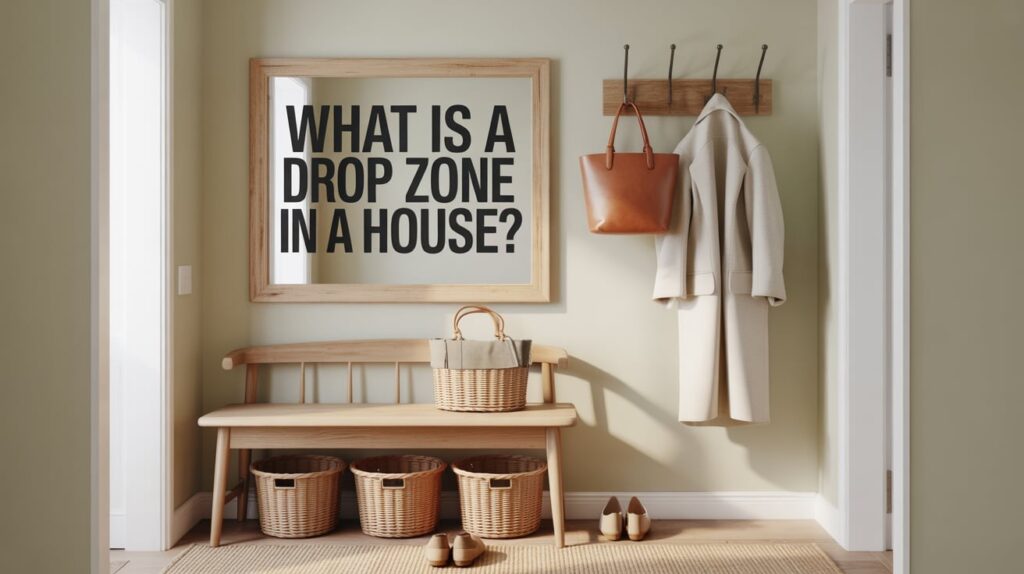You toss your keys somewhere. Your bag lands on the floor. Mail gets scattered across the counter. Before you know it, your entrance looks like a tornado hit it.
That’s where a drop zone saves the day.
Think of it as your home’s command center. A simple, organized spot where everything has its place. No more frantic searches for car keys when you’re already running late.
You don’t need expensive renovations or tons of space. Even a small corner can become your family’s organizing hero.
In this guide, you’ll learn what a drop zone is, how it works, and stylish ways to create your own. Whether you have a grand foyer or just a tiny corner, I’ll show you how to turn chaos into calm.
Ready to reclaim your sanity?
Let’s start.
What Is a Drop Zone in a House?
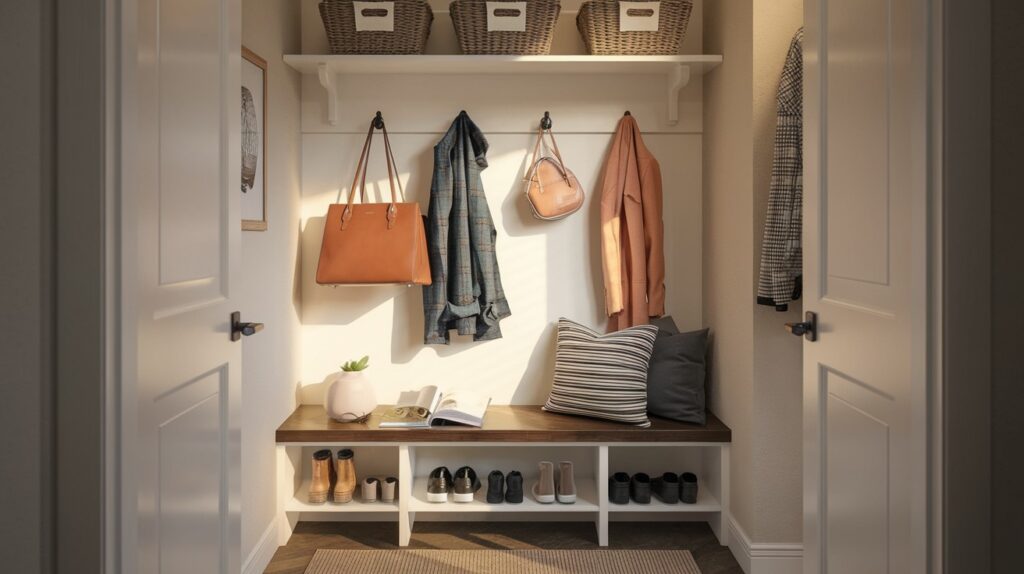
A drop zone is your home’s designated landing pad.
It’s a specific area near your entrance where everyday items live. Keys, bags, mail, shoes – they all have a home here instead of being scattered throughout your house.
Think of it as a pit stop.
When you walk in, you drop off what you don’t need. When you leave, you grab what you do need. Simple as that.
The magic happens because everything stays in one place. No more hunting for your wallet in three different rooms. No more stepping over shoes in the hallway.
Your drop zone doesn’t need to be fancy. It just needs to work for your life.
How to Create a Drop Zone
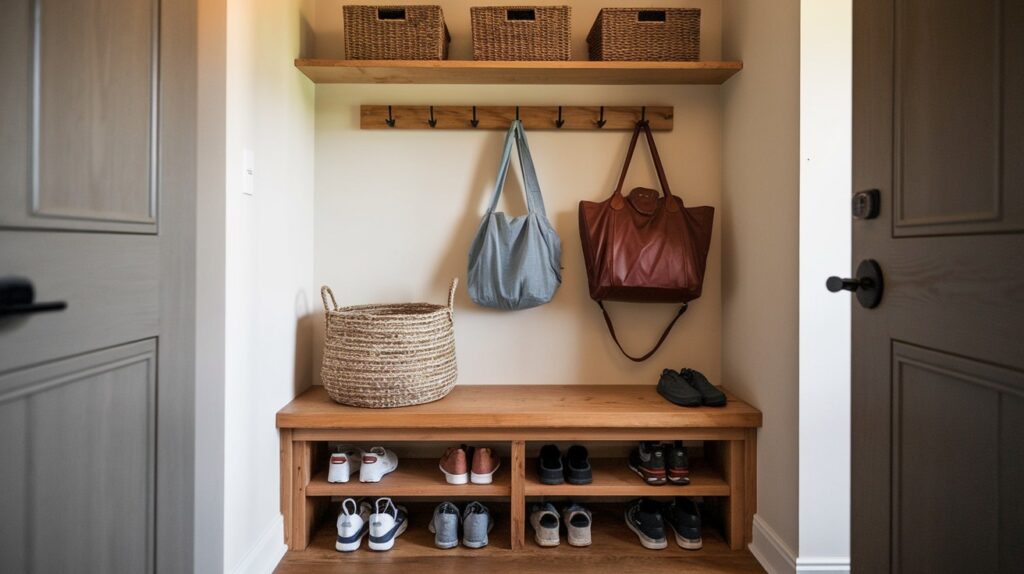
Creating a drop zone starts with picking the right spot.
Look for an area near your main entrance. It should be easy to reach but not block traffic flow. You want convenience, not obstacles.
Next, think about what you actually use every day. Don’t plan for items you touch once a month. Focus on the stuff that moves in and out with you regularly.
Start small and build up. You can always add more storage later.
Common Places to Create a Drop Zone
Entryway or mudroom: This is the obvious choice if you have the space. It’s right where you need it most.
Hallway nook: That awkward corner everyone ignores? Perfect drop zone material.
Kitchen corner: Many families naturally gravitate toward the kitchen. Use that traffic pattern to your advantage.
Garage entry: If you come and go through the garage, set up shop right inside that door.
Inside a closet: The inside of a coat closet works great with some smart organization.
Don’t need a full room – just a small, organized surface or wall section can work.
Essential Elements of a Functional Drop Zone
Your drop zone needs these basics to work:
Hooks for bags, coats, or hats: Install them at different heights if you have kids. Everyone should be able to reach their spot.
Small bins or baskets for mail and keys: Separate containers prevent a jumbled mess. Label them if it helps.
A bench or seat with shoe storage: Gives you somewhere to sit while putting on shoes. Hidden storage underneath is a bonus.
Charging station for devices: Modern life requires charged phones. Build this into your system from the start.
Stylish Drop Zone Ideas for Every Home
Modern minimal
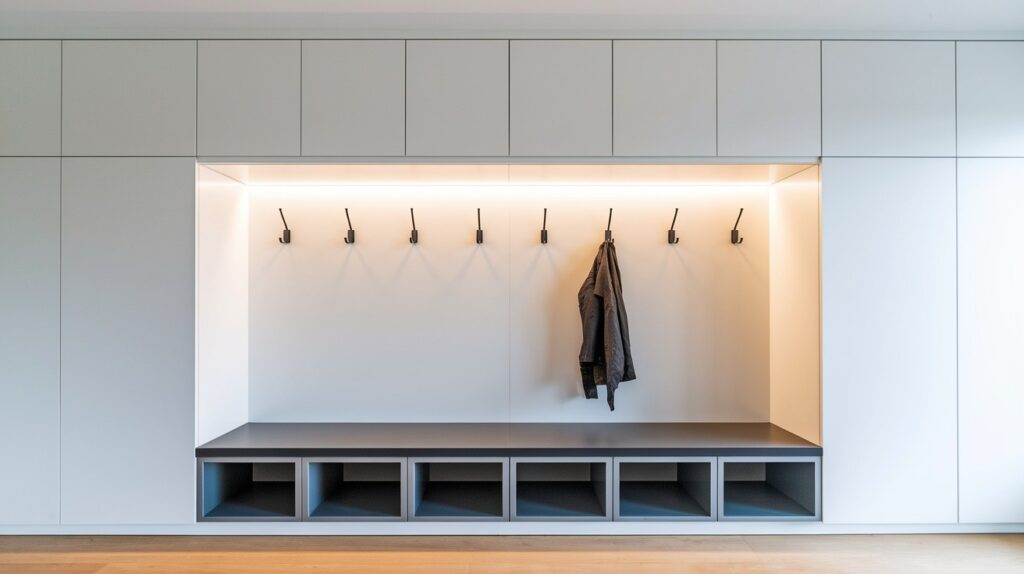
Clean lines rule here. Use a floating shelf with sleek metal hooks underneath. Hide storage in closed cubbies to keep the look streamlined.
Stick to neutral colors like white, black, or gray. The key is making everything look intentional, not cluttered.
Rustic charm
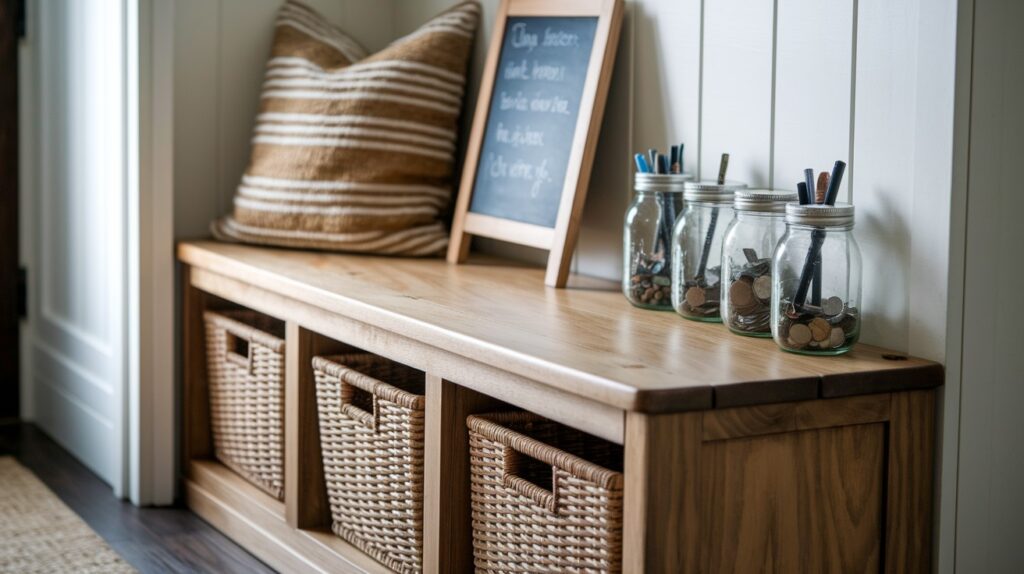
Warm wood makes everything feel cozy. Try a wooden bench with wicker baskets tucked underneath.
Add a small chalkboard for notes. Mason jars can hold smaller items like pens or loose change. This style works especially well in farmhouse or cottage-style homes.
Small space hack
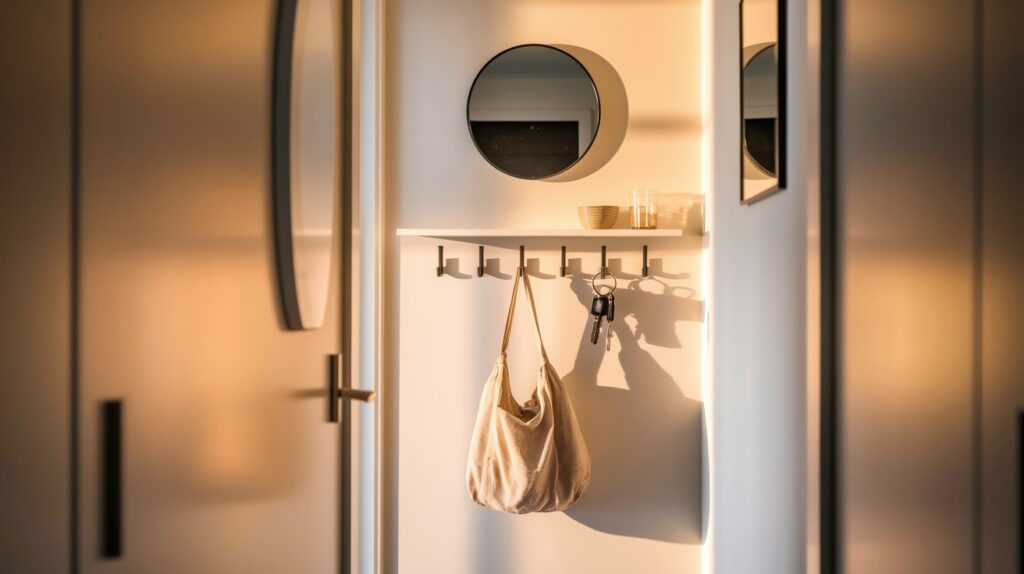
Wall-mounted organizers save floor space. Combine a narrow shelf with hooks and a small mirror.
The mirror makes your space feel bigger while serving a practical purpose. This approach works great in apartments or narrow hallways.
Family-focused
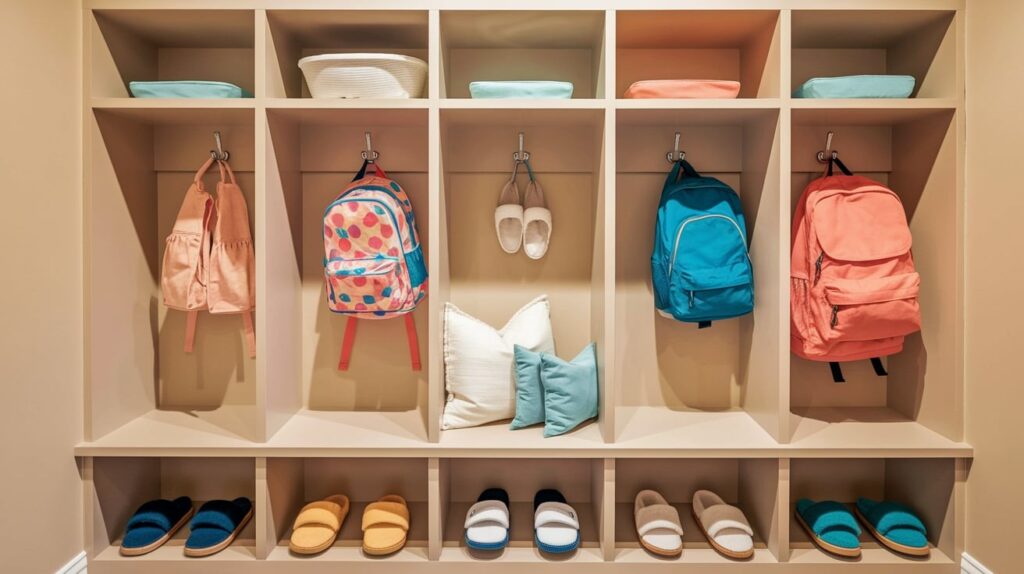
Give everyone their own space. Individual cubbies or hooks prevent arguments about whose stuff is whose.
Use different colors or labels for each family member. Consider adding a small bench so kids can sit while putting on their shoes.
Boho vibes
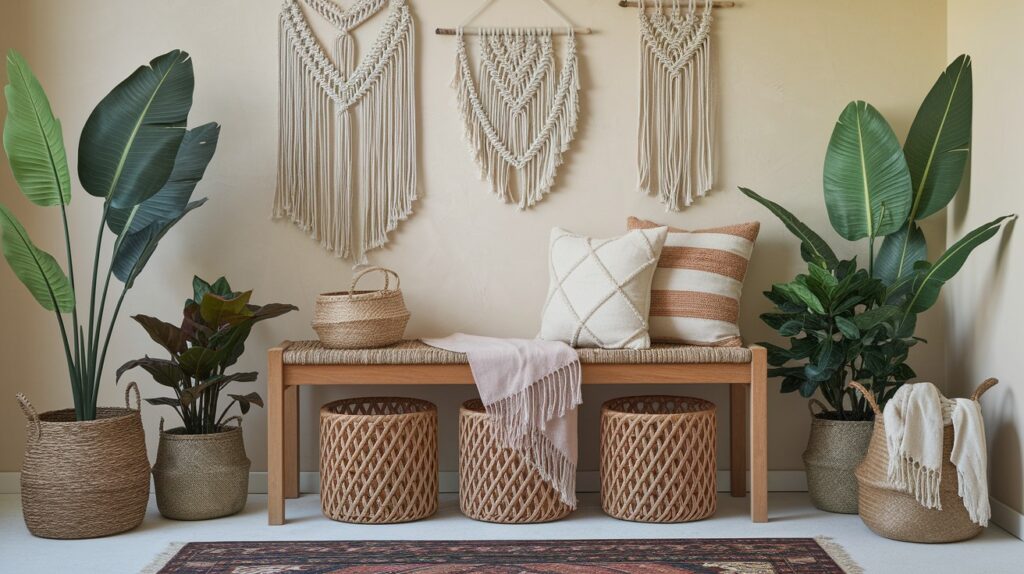
Mix textures and natural materials. Rattan baskets, macrame wall hangings, and a few plants create that relaxed, organic feel.
Earth tones like terracotta and sage green work well here. Add a vintage rug to define the space and make it feel cozy.
DIY Drop Zone Tips
You don’t need to spend a fortune to get organized.
- Repurpose old furniture: Console tables and bookshelves make great drop zone bases. Add baskets or bins to create designated spaces within the larger piece.
- Use command hooks instead of installing racks: Perfect for renters or anyone who doesn’t want to drill holes. They hold more weight than you’d expect.
- IKEA hacks for compact spaces: Their RÅSKOG cart works great as a mobile drop zone. The ALGOT system can be customized for any wall space.
- Label bins to stay organized: Clear labels help everyone know where things belong. Use a label maker or just masking tape and a marker.
Start with what you have before buying new items.
Benefits of Having a Drop Zone
- Reduces entryway clutter
- Saves time when leaving the house
- Keeps essentials in one place
- Makes a stylish first impression
- Helps kids learn organization early
- Reduces stress from lost items
- Creates a welcoming atmosphere
- Protects floors from wet shoes and bags
Maintenance: How to Keep Your Drop Zone Neat
- Set a weekly 5-minute reset
- Keep a donation bin nearby for items you no longer need
- Rotate seasonal items (heavy coats in summer, flip-flops in winter)
- Create a “no overflow” rule – if it doesn’t fit, something else has to go
- Wipe down surfaces regularly
- Check that hooks and hardware stay secure
- Involve the whole family in maintenance
Conclusion
A drop zone brings order to everyday chaos with a blend of function and style. It’s not about perfection. It’s about creating a system that works for your real life.
Start with the basics. Add what you need. Skip what you don’t.
The goal is to make your daily routine smoother, not to create another chore. When your drop zone works, you’ll wonder how you ever lived without it.
Your morning rush becomes calmer. Your entrance looks better. Your stress levels drop.
Ready to improve your entryway? Start small, stay consistent, and add your style twist.
Pick one area this weekend. Set up a simple hook and basket system. Use it for a week and see how it feels. You might be surprised at the difference such a small change can make.
Frequently Asked Questions
What exactly should go in a drop zone?
Stick to everyday essentials like keys, phones, mail, shoes, bags, and sometimes jackets. Avoid storing items you only use occasionally – they’ll just create clutter.
Can I make a drop zone if I don’t have a mudroom?
Absolutely! Use a corner of the hallway, kitchen, or even a closet with smart storage. The key is choosing a spot near your main entrance that everyone will use.
How much space do I need for a drop zone?
You can start with as little as 2 feet of wall space – it’s all about smart organization. A small shelf with hooks underneath can handle the basics for most families.
Is a drop zone the same as a mudroom?
Not exactly. A mudroom is usually a larger, separate entry area with more storage and sometimes a sink. A drop zone is smaller and more focused on organizing daily essentials.
How can I make my drop zone look stylish?
Use coordinated baskets, decorative hooks, and keep your color scheme consistent. A mirror or piece of art can make the space feel intentional rather than just functional.

